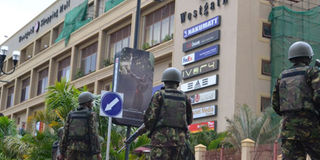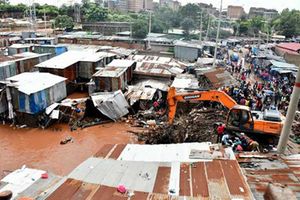How Kenya took the fight to al-Shabaab

KDF soldiers surrounding Westgate mall on September 21, 2013. PHOTO/ JEFF ANGOTE
What you need to know:
- Operation Linda Nchi was declared at an open press conference by two ministers, Prof George Saitoti (Internal Security) and his Defence counterpart, Yusuf Haji.
- Consequently, ground, air, and navy personnel would pursue the militants into Somalia.
- There had already been movement of hardware and trucks from various garrisons the previous night.
Kenyan troops crossed the border into Somalia to engage al-Shabaab, the Islamic militants blamed for a series of attacks at the coast and in the north of the country.
A number of Kenyans had been killed in the attacks, but the reaction came after the al-Qaeda-linked insurgents targeted tourism.
The foray into Somalia has since cost the country a lot financially and in terms of human lives.
Operation Linda Nchi was declared at an open press conference by two ministers, Prof George Saitoti (Internal Security) and his Defence counterpart, Yusuf Haji.
They told the world that the government was invoking Article 51 of the United Nations Charter “on self-defence” to defend its territory.
Consequently, ground, air, and navy personnel would pursue the militants into Somalia. There had already been movement of hardware and trucks from various garrisons the previous night.
A series of events prompted Kenya to take the hard decision, given that the army had not engaged in any war since the Shifta insurgence of the 1960s.
In August, al-Shabaab had been routed from their Mogadishu strongholds by African Union troops in bloody street-to-street combat.
FLED TOWARDS SOMALIA
Some fled towards northern Somalia, but the majority moved south towards Kenya. The militia carried out attacks in Kenya, killing and abducting for ransom.
They had abducted aid workers in Dadaab — where 525,000 Somali refugees live — the day before Kenya decided to move.
But the provocation had begun as early as 2009, when they attacked a police post in Dajabula and abucted two nuns in Elwak. The following year, they attacked a General Service Unit camp.
The attacks increased in 2011, with border violations in Mandera where they abducted two soldiers, whom the government declared missing in action.
In September, they killed a British tourist, David Tabutt, in Lamu, and abducted his wife, Ruth.
In October, they kidnapped a Frenchwoman, Marie Dedieu, from her Manda home. They also attacked a navy boat on patrol and two soldiers went missing.
These attacks were used to justify the declaration of Operation Linda Nchi. The assault had three objectives: To secure Kenya’s borders, take over territory under al-Shabaab’s control, and neutralise the group.
Britain, the US, and the European Union backed Kenya’s actions. The ultimate prize was taking over the port city of Kismayu, al-Shabaab’s main economic lifeline.
The first objective was achieved within two days, when the Kenyan troops ensured that al-Shabaab did not operate in a buffer zone of 100 kilometres within Somalia. But this came at a price.
A military helicopter crashed shortly after taking off from Liboi, killing all five soldiers on board.
The second phase involved more airstrikes targeting two major towns inside Somalia. In Jilib, the airstrikes killed 10 of the al-Shabaab leaders before the militiamen disappeared.
Afmadow, a town al-Shabaab had controlled for two years, was the next target. It was important to militia, who were using it as a transit station for storing contraband goods from Kismayu port.
Capturing the town was seen as the first step to starving al-Shabaab of income.
THIRD PHASE
Diplomacy and military operations marked the third phase. In Nairobi, former Prime Minister Raila Odinga held a meeting with his Somalia counterpart, Abdwell Mohammed Ali.
They emerged to announce that Kenya would go to the UN to seek an international blockade of Kismayu port to cut off al-Shabaab’s supply route.
The fight for Kismayu was a drawn out operation using combined ground, air, and naval troops. The entry into Kismayu was celebrated by both the local and international communities.
The operation within Somalia sparked off what was thought to be revenge attacks in Kenya. Bomb attacks on a church and entertainment places in Garissa last year resulted in casualties and injuries.
There have been similar attacks in Wajir and Mandera. There were even attacks in Nairobi. A bomb was hurled into a church in Ngara as worshippers prayed while another was planted in a matatu on Juja Road.
Two attacks this year have been associated with al-Shabaab operatives, including the September one on the Westgate Mall in 70 people were killed.
Although the government has not made public the bill for Operation Linda Nchi, it is definitely running into billions as the soldiers still continue to operate inside Somalia.


